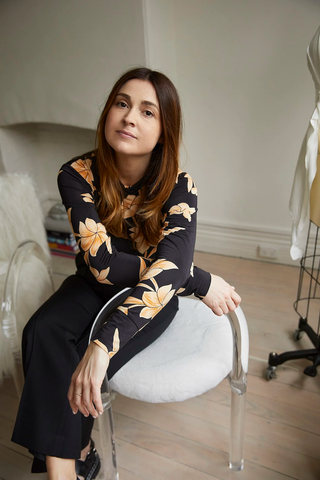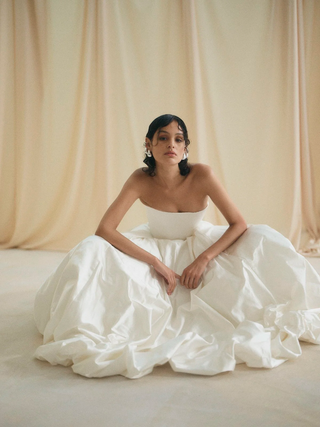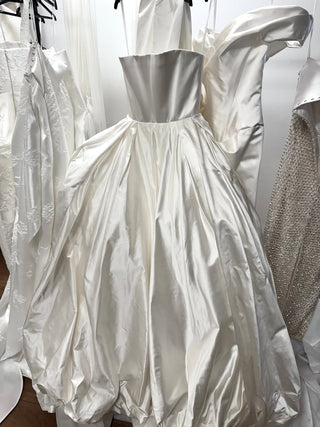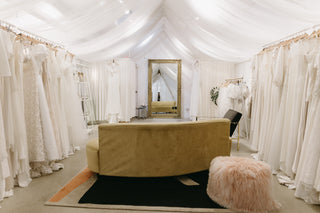
Interview with Bridal Designer Prea James
By: Gwynneth Tansey
A bit about Prea James -
Prea James gowns have been best sellers at Loversland for many years now. As a bridal stylist, an appointment rarely goes by without at least one Prea James dress being tried on. Our team loves them for their understated elegance and how well suited they are to the bride who wants something modern yet unique.
Designed and made in Australia, Prea James has been making made-to-measure couture dresses since 2012 and introduced made-to-order gowns through Prea James Bridal in 2017. Ahead of Loverland’s Prea James trunk show featuring the Studio 02 collection, I had the opportunity to ask Prea some questions about her designs and intentions behind what she creates.

Q: How would you describe the Prea James bride, and how does Studio 02 speak to her?
PJ: I think our bride is quite considered in her approach to finding her look for the day. She understands the difference between trends and style and values pieces that feel enduring over those designed for impact alone. While I do design with an awareness of trends, I would say they show in the finer details rather than being the main focal point. If I do add in more trend driven styles, they are integrated in a way that feels timeless rather than transient. Adding relevance without compromising elegance. I think the pieces in the Studio Collection 02 are exactly that.
Q: Were there particular fabrics or silhouettes you were drawn to with this collection?
PJ: I think for this collection for most of the pieces I designed the silhouettes before choosing the fabrics, which normally fabrics are chosen first. But I am often sketching silhouettes or draping on the mannequin and there were some shapes I just knew I wanted to bring to life. So, I had to find fabrics that would work with the silhouette.
The Delphine was easy because we use the silk duchess already and I knew it was perfect for this dress! The Minha dress was originally going to be in the French Lace that the Martine Mini is in, but it didn't feel quite right when I draped the lace over the shape. It just happened that one of the fabric agents came to show me some brocades and as soon as I saw the floral brocade she ended up being made in, I knew it was perfect! The overskirt was actually an after-thought once the dress was made. I think due to the architectural shape of the dress, I wanted to make the overskirt quite sculptural too and had a sort of silhouette in mind. Using the brocade, I played with fabric on the dummy with all of the folds and tucks and it came together very quickly. (Even though my pattern maker didn't seem that impressed with me, we made it work.)

Q: What is an important piece of your creative process when developing a new collection?
PJ: That's hard, it all feels important in its own way. I want to say development time... because I always feel like there's not enough and I could keep going forever, making little updates to build on the design... because often I get to the sample phase and have a great idea to make it even better, but I don't have time. However, at the same time, I do think a little bit of time pressure helps me in a way, as often those last minute designs end up being top sellers. And as my niece always tells me, diamonds are made under pressure - so maybe I need a bit of pressure. Undecided!
Q: How do sustainability and thoughtful production play into your design process?
In a few ways actually. I did read once how many samples were wasted yearly by brands on average and it was alarming. The samples were mostly development samples that then didn't make it into production. So, I start here actually, by taking more time to plan collections and carefully select designs that I feel confident with.
I also started making smaller yearly collections so that we are releasing the strong pieces and not filling it out for the sake of having a big collection.
I do try as much as possible to use silk and other natural fibres - silk of course does completely break down. We have a digital pattern maker & grader who can create what are called markers, so that the pattern pieces are laid on the fabric in a way that wastes as little fabric as possible.
We buy bulk fabric amounts where possible, which helps to reduce freight, which has an environmental impact on its own. Instead of ordering small amounts of fabric more often, we invest in larger quantities to have on hand, so we may only need to freight each fabric every 3-6 months for example.
And of course, all of the Studio collection pieces are made by our in-house team, so there is less shipping involved in the production process - we do not have them made off-shore, for example, brought in house to check and then sent out again.

